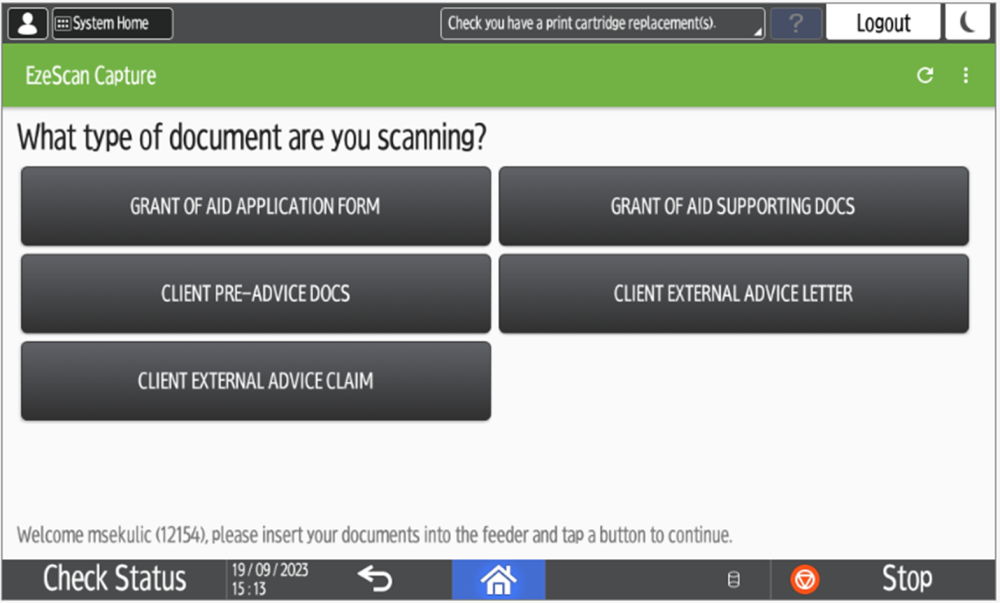Legal Aid Queensland Pivots to Decentralised Document Capture
A Decentralised Records Capture System from EzeScan has made life easier for Legal Aid Queensland in its role providing legal services to financially disadvantaged people across the state.
With over 700 full-time employees spread across 13 regional offices, Legal Aid Queensland processes more than 50,000 paper-based applications for aid each year. Until recently, these applications were physically couriered from each regional office to the Brisbane Head Office, where they were digitised and entered into the organisation's records management system, Content Manager.
The discontinuation of the DX Document Delivery Service by TOLL Group, which had provided overnight document exchange between offices, forced Legal Aid Queensland to pivot from having a well-established, but highly centralised record capture operation and mailroom located in Brisbane, to decentralising this function so that records received in its regional offices are captured into core business systems and Content Manager in the shortest possible time and at minimal expense.
With EzeScan powering its existing centralised capture solution, Michael Johnston, Manager Records and Information at Legal Aid Queensland turned to EzeScan for a swift solution.
“We were an existing EzeScan customer and became aware of their decentralised capture solutions which utilises their Web Applications to provide capture capabilities to anyone in the organisation. This showed promise to allow our fleet of Ricoh Multi-Function Devices (MFDs) across the state to provide the same capture function that was previously provided in our Brisbane mailroom,” said Johnston.
Key to the solution was EzeScan’s Ricoh Capture App which turns any Ricoh MFD with a ‘Smart Panel’ screen into a mailroom capable document scanner, integrating directly with EzeScan’s WebApps allowing users to select and initiate capture workflows.
“The integration between EzeScan WebApps and Content Manager is just completely seamless,” said Johnston.
“We're able to utilise a lot of our existing information without requiring people to re-enter it.
“It’s not a big trick for a system to recognise the logged in user and know who they are, but via integration with Content Manager, which has our entire organisation structure in it, we can for example not only tell who the person using the system is, but also their supervisor and then their supervisor.
“So, if specific processes need to get a manager’s approval or a director’s approval, we can workflow all of that by using the information that's already in our systems. So that's a really big win for us.”
One of Legal Aid Queensland’s most document-intensive workflows is Legal Aid application forms which are typically accompanied by bundles of supporting documents, bank statements and more.
“When you scan an application form, the server now picks it up and then EzeScan immediately emails you a digitisation cover sheet which can be printed out and used as a scanning cover sheet for all the supporting documents. The barcode will relate all the supporting documents back to the original application,” said Johnston.
“When they’ve finished scanning all the copies in a regional office, all the documents are put back together in a plastic sleeve and sent back to Brisbane where we allocate an archiving box. We then just need to scan the barcode on the cover sheet to know where all the supporting documents are.”
Another ongoing process that generates a lot of paperwork is the recruitment process. Three people on an interview panel will all be taking notes throughout the course of the interview, all of which must be captured.
Johnston said one of the attractions of EzeScan WebApps was the ability to generate customised cover sheets for scanning jobs
“Originally, we had dozens of separate scan jobs in EzeScan for different workflows. Now, all the variables for all those different jobs are encoded in the cover sheets, so we only need two main scan jobs: one for grayscale and one for colour. If something changes, we just update one job instead of managing dozens.”
“And if there's a new process that comes online really quickly, which can happen as Government priorities and court procedures change, instead of having to go and programme up a whole new job, I have a table in the EzeScan Authority Server with all the different scan job variations. So, you just select the variation that you want on the cover sheet and then all of those variables are encoded in the barcode on the cover sheet.
“That's also been huge for us because previously even a small change would have dozens of flow-on effects.”
The agency is also underway with an extensive backscanning operation across its regional offices to free up space for staff.
The scanned documents are then sent to Brisbane for storage.
“We are still doing a lot of QA checking but our ultimate goal is, where the Public Record Act allows, us to destroy the hard copies for certain documents,” said Johnston.

A screengrab of the EzeScan Capture app on the Ricoh MFDs which helps to identify the correct workflow for scanned documents.
